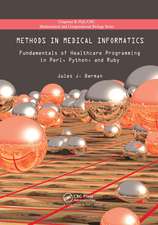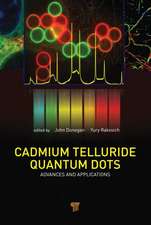A Handbook of Intelligent Healthcare Analytics – Knowledge Engineering with Big Data: Machine Learning in Biomedical Science and Healthcare Informatics
Autor A Jayaen Limba Engleză Hardback – 23 mai 2022
Preț: 1087.97 lei
Preț vechi: 1431.54 lei
-24% Nou
Puncte Express: 1632
Preț estimativ în valută:
208.22€ • 216.28$ • 172.95£
208.22€ • 216.28$ • 172.95£
Carte disponibilă
Livrare economică 13-27 ianuarie 25
Livrare express 27 decembrie 24 - 02 ianuarie 25 pentru 38.21 lei
Preluare comenzi: 021 569.72.76
Specificații
ISBN-13: 9781119791799
ISBN-10: 1119791790
Pagini: 448
Dimensiuni: 161 x 231 x 29 mm
Greutate: 0.73 kg
Editura: Wiley
Seria Machine Learning in Biomedical Science and Healthcare Informatics
Locul publicării:Hoboken, United States
ISBN-10: 1119791790
Pagini: 448
Dimensiuni: 161 x 231 x 29 mm
Greutate: 0.73 kg
Editura: Wiley
Seria Machine Learning in Biomedical Science and Healthcare Informatics
Locul publicării:Hoboken, United States
Notă biografică
A. Jaya PhD, Professor in the Department of Computer Applications, B. S. Abdur Rahman Crescent Institute of Science and Technology, India. She published more than 90 research articles in international journals K. Kalaiselvi PhD, is a Professor and Head in the Department of Computer Science, School of Computing Sciences, Vels Institute of Science, Technology and Advanced Studies, Chennai, India. She has published more than 50 research articles in international journals Dinesh Goyal PhD, is Principal at the Poornima Institute of Engineering & Technology, Jaipur, India. He has 6 patents published & as well as 6 books and numerous articles. Dhiya Al-Jumeily PhD, is a professor of Artificial Intelligence and the Associate Dean of External Engagement for the Faculty of Engineering and Technology, Liverpool John Moores University, UK. He has published well over 200 peer reviewed scientific publications, 6 books and 5 book chapters. But his current research are is decision support systems for self-management of health and disease.
Cuprins
Preface xvii
1 An Introduction to Knowledge Engineering and Data Analytics 1
D. Karthika and K. Kalaiselvi
1.1 Introduction 2
1.1.1 Online Learning and Fragmented Learning Modeling 2
1.2 Knowledge and Knowledge Engineering 5
1.2.1 Knowledge 5
1.2.2 Knowledge Engineering 5
1.3 Knowledge Engineering as a Modelling Process 6
1.4 Tools 7
1.5 What are KBSs? 8
1.5.1 What is KBE? 8
1.5.2 When Can KBE Be Used? 10
1.5.3 CAD or KBE? 12
1.6 Guided Random Search and Network Techniques 13
1.6.1 Guide Random Search Techniques 13
1.7 Genetic Algorithms 14
1.7.1 Design Point Data Structure 15
1.7.2 Fitness Function 15
1.7.3 Constraints 16
1.7.4 Hybrid Algorithms 16
1.7.5 Considerations When Using a GA 16
1.7.6 Alternative to Genetic-Inspired Creation of Children 17
1.7.7 Alternatives to GA 18
1.7.8 Closing Remarks for GA 18
1.8 Artificial Neural Networks 19
1.9 Conclusion 19
References 20
2 A Framework for Big Data Knowledge Engineering 21
Devi T. and Ramachandran A.
2.1 Introduction 22
2.1.1 Knowledge Engineering in AI and Its Techniques 23
2.1.1.1 Supervised Model 23
2.1.1.2 Unsupervised Model 23
2.1.1.3 Deep Learning 24
2.1.1.4 Deep Reinforcement Learning 24
2.1.1.5 Optimization 25
2.1.2 Disaster Management 25
2.2 Big Data in Knowledge Engineering 26
2.2.1 Cognitive Tasks for Time Series Sequential Data 27
2.2.2 Neural Network for Analyzing the Weather Forecasting 27
2.2.3 Improved Bayesian Hidden Markov Frameworks 28
2.3 Proposed System 30
2.4 Results and Discussion 32
2.5 Conclusion 33
References 36
3 Big Data Knowledge System in Healthcare 39
P. Sujatha, K. Mahalakshmi and P. Sripriya
3.1 Introduction 40
3.2 Overview of Big Data 41
3.2.1 Big Data: Definition 41
3.2.2 Big Data: Characteristics 42
3.3 Big Data Tools and Techniques 43
3.3.1 Big Data Value Chain 43
3.3.2 Big Data Tools and Techniques 45
3.4 Big Data Knowledge System in Healthcare 45
3.4.1 Sources of Medical Big Data 51
3.4.2 Knowledge in Healthcare 53
3.4.3 Big Data Knowledge Management Systems in Healthcare 55
3.4.4 Big Data Analytics in Healthcare 56
3.5 Big Data Applications in the Healthcare Sector 59
3.5.1 Real Time Healthcare Monitoring and Altering 59
3.5.2 Early Disease Prediction with Big Data 59
3.5.3 Patients Predictions for Improved Staffing 61
3.5.4 Medical Imaging 61
3.6 Challenges with Healthcare Big Data 62
3.6.1 Challenges of Big Data 62
3.6.2 Challenges of Healthcare Big Data 62
3.7 Conclusion 64
References 64
4 Big Data for Personalized Healthcare 67
Dhanalakshmi R. and Jose Anand
4.1 Introduction 68
4.1.1 Objectives 68
4.1.2 Motivation 69
4.1.3 Domain Description 70
4.1.4 Organization of the Chapter 70
4.2 Related Literature 71
4.2.1 Healthcare Cyber Physical System Architecture 71
4.2.2 Healthcare Cloud Architecture 71
4.2.3 User Authentication Management 72
4.2.4 Healthcare as a Service (HaaS) 72
4.2.5 Reporting Services 73
4.2.6 Chart and Trend Analysis 73
4.2.7 Medical Data Analysis 73
4.2.8 Hospital Platform Based On Cloud Computing 74
4.2.9 Patient's Data Collection 74
4.2.10 H-Cloud Challenges 75
4.2.11 Healthcare Information System and Cost 75
4.3 System Analysis and Design 75
4.3.1 Proposed Solution 76
4.3.2 Software Components 76
4.3.3 System Design 76
4.3.4 Architecture Diagram 77
4.3.5 List of Modules 78
4.3.6 Use Case Diagram 81
4.3.7 Sequence Diagram 81
4.3.8 Class Diagram 82
4.4 System Implementation 83
4.4.1 User Interface 83
4.4.2 Storage Module 84
4.4.3 Notification Module 85
4.4.4 Middleware 86
4.4.5 OTP Module 87
4.5 Results and Discussion 88
4.6 Conclusion 90
References 90
5 Knowledge Engineering for AI in Healthcare 93
A. Thirumurthi Raja and B. Mahalakshmi
5.1 Introduction 94
5.2 Overview 95
5.2.1 Knowledge Representation 95
5.2.2 Types of Knowledge in Artificial Intelligence 96
5.2.3 Relation Between Knowledge and Intelligence 97
5.2.4 Approaches to Knowledge Representation 97
5.2.5 Requirements for Knowledge Representation System 98
5.2.6 Techniques of Knowledge Representation 98
5.2.6.1 Logical Representation 99
5.2.6.2 Semantic Network Representation 99
5.2.6.3 Frame Representation 99
5.2.6.4 Production Rules 100
5.2.7 Process of Knowledge Engineering 101
5.2.8 Knowledge Discovery Process 106
5.3 Applications of Knowledge Engineering in AI for Healthcare 106
5.3.1 AI Supports in Clinical Decisions 107
5.3.2 AI-Assisted Robotic Surgery 107
5.3.3 Enhance Primary Care and Triage 108
5.3.4 Clinical Judgments or Diagnosis 108
5.3.5 Precision Medicine 109
5.3.6 Drug Discovery 109
5.3.7 Deep Learning to Diagnose Diseases 110
5.3.8 Automating Administrative Tasks 111
5.3.9 Reducing Operational Costs 112
5.3.10 Virtual Nursing Assistants 113
5.4 Conclusion 113
References 114
6 Business Intelligence and Analytics from Big Data to Healthcare 115
Maheswari P., A. Jaya and João Manuel R. S. Tavares
6.1 Introduction 116
6.1.1 Impact of Healthcare Industry on Economy 116
6.1.2 Coronavirus Impact on the Healthcare Industry 117
6.1.3 Objective of the Study 117
6.1.4 Limitations of the Study 117
6.2 Related Works 118
6.3 Conceptual Healthcare Stock Prediction System 120
6.3.1 Data Source 122
6.3.2 Business Intelligence and Analytics Framework 122
6.3.2.1 Simple Machine Learning Model 122
6.3.2.2 Time Series Forecasting 123
6.3.2.3 Complex Deep Neural Network 123
6.3.3 Predicting the Stock Price 124
6.4 Implementation and Result Discussion 124
6.4.1 Apollo Hospitals Enterprise Limited 125
6.4.2 Cadila Healthcare Ltd 125
6.4.3 Dr. Reddy's Laboratories 128
6.4.4 Fortis Healthcare Limited 130
6.4.5 Max Healthcare Institute Limited 131
6.4.6 Opto Circuits Limited 131
6.4.7 Panacea Biotec 135
6.4.8 Poly Medicure Ltd 136
6.4.9 Thyrocare Technologies Limited 138
6.4.10 Zydus Wellness Ltd 138
6.5 Comparisons of Healthcare Stock Prediction Framework 141
6.6 Conclusion and Future Enhancement 143
References 143
Books 145
Web Citation 145
7 Internet of Things and Big Data Analytics for Smart Healthcare 147
Sathish Kumar K., Om Prakash P.G., Alangudi Balaji N. and Robertas Damasevi ius
7.1 Introduction 148
7.2 Literature Survey 149
7.3 Smart Healthcare Using Internet of Things and Big Data Analytics 151
7.3.1 Smart Diabetes Prediction 151
7.3.2 Smart ADHD Prediction 154
7.4 Security for Internet of Things 159
7.4.1 K(Binary) ECC FSM 159
7.4.2 NAF Method 160
7.4.3 K-NAF Multiplication Architecture 161
7.4.4 K(NAF) ECC FSM 161
7.5 Conclusion 164
References 165
8 Knowledge-Driven and Intelligent Computing in Healthcare 167
R. Mervin, Dinesh Mavalaru and Tintu Thomas
8.1 Introduction 168
8.1.1 Basics of Health Recommendation System 169
8.1.2 Basics of Ontology 169
8.1.3 Need of Ontology in Health Recommendation System 170
8.2 Literature Review 171
8.2.1 Ontology in Various Domain 172
8.2.2 Ontology in Health Recommendation System 174
8.3 Framework for Health Recommendation System 175
8.3.1 Domain Ontology Creation 176
8.3.2 Query Pre-Processing 178
8.3.3 Feature Selection 179
8.3.4 Recommendation System 180
8.4 Experimental Results 182
8.5 Conclusion and Future Perspective 183
References 183
9 Secure Healthcare Systems Based on Big Data Analytics 189
A. Angel Cerli, K. Kalaiselvi and Vijayakumar Varadarajan
9.1 Introduction 190
9.2 Healthcare Data 193
9.2.1 Structured Data 193
9.2.2 Unstructured Data 194
9.2.3 Semi-Structured Data 194
9.2.4 Genomic Data 194
9.2.5 Patient Behavior and Sentiment Data 194
9.2.6 Clinical Data and Clinical Notes 194
9.2.7 Clinical Reference and Health Publication Data 195
9.2.8 Administrative and External Data 195
9.3 Recent Works in Big Data Analytics in Healthcare Data 195
9.4 Healthcare Big Data 197
9.5 Privacy of Healthcare Big Data 198
9.6 Privacy Right by Country and Organization 200
9.7 How Blockchain is Big Data Usable for Healthcare 200
9.7.1 Digital Trust 200
9.7.2 Smart Data Tracking 202
9.7.3 Ecosystem Sensible 202
9.7.4 Switch Digital 202
9.7.5 Cybersecurity 203
9.7.6 Sharing Interoperability and Data 203
9.7.7 Improving Research and Development (R&D) 206
9.7.8 Drugs Fighting Counterfeit 206
9.7.9 Patient Mutual Participation 206
9.7.10 Internet Access by Patient to Longitudinal Data 206
9.7.11 Data Storage into Off Related to Confidentiality and Data Scale 207
9.8 Blockchain Threats and Medical Strategies Big Data Technology 207
9.9 Conclusion and Future Research 208
References 208
10 Predictive and Descriptive Analysis for Healthcare Data 213
Pritam R. Ahire and Rohini Hanchate
10.1 Introduction 214
10.2 Motivation 215
10.2.1 Healthcare Analysis 215
10.2.2 Predictive Analytics 217
10.2.3 Predictive Analytics Current Trends 217
10.2.3.1 Importance of PA 217
10.2.4 Descriptive Analysis 218
10.2.4.1 Descriptive Statistics 218
10.2.4.2 Categories of Descriptive Analysis 219
10.2.5 Method of Modeling 221
10.2.6 Measures of Data Analytics 221
10.2.7 Healthcare Data Analytics Platforms and Tools 223
10.2.8 Challenges 225
10.2.9 Issues in Predictive Healthcare Analysis 226
10.2.9.1 Integrating Separate Data Sources 226
10.2.9.2 Advanced Cloud Technologies 226
10.2.9.3 Privacy and Security 227
10.2.9.4 The Fast Pace of Technology Changes 227
10.2.10 Applications of Predictive Analysis 227
10.2.10.1 Improving Operational Efficiency 227
10.2.10.2 Personal Medicine 228
10.2.10.3 Population Health and Risk Scoring 228
10.2.10.4 Outbreak Prediction 228
10.2.10.5 Controlling Patient Deterioration 228
10.2.10.6 Supply Chain Management 228
10.2.10.7 Potential in Precision Medicine 229
10.2.10.8 Cost Savings From Reducing Waste and Fraud 229
10.3 Conclusion 229
References 229
11 Machine and Deep Learning Algorithms for Healthcare Applications 233
K. France, A. Jaya and Doru Tiliute
11.1 Introduction 234
11.2 Artificial Intelligence, Machine Learning, and Deep Learning 234
11.3 Machine Learning 236
11.3.1 Supervised Learning 236
11.3.2 Unsupervised Learning 238
11.3.3 Semi-Supervised 238
11.3.4 Reinforcement Learning 238
11.4 Advantages of Using Deep Learning on Top of Machine Learning 239
11.5 Deep Learning Architecture 239
11.6 Medical Image Analysis using Deep Learning 242
11.7 Deep Learning in Chest X-Ray Images 243
11.8 Machine Learning and Deep Learning in Content-Based Medical Image Retrieval 246
11.9 Image Retrieval Performance Metrics 249
11.10 Conclusion 250
References 250
12 Artificial Intelligence in Healthcare Data Science with Knowledge Engineering 255
S. Asha, Kanchana Devi V. and G. Sahaja Vaishnavi
12.1 Introduction 256
12.2 Literature Review 260
12.3 AI in Healthcare 266
12.4 Data Science and Knowledge Engineering for COVID-19 268
12.5 Proposed Architecture and Its Implementation 270
12.5.1 Implementation 270
12.5.1.1 Data Collection 270
12.5.1.2 Understanding Class and Dependencies 270
12.5.1.3 Pre-Processing 272
12.5.1.4 Sampling 273
12.5.1.5 Model Fixing 273
12.5.1.6 Analysis of Real-Time Datasets 273
12.5.1.7 Machine Learning Algorithms 276
12.6 Conclusions and Future Work 278
References 280
13 Knowledge Engineering Challenges in Smart Healthcare Data Analysis System 285
Agasba Saroj S. J., B. Saleena and B. Prakash
13.1 Introduction 285
13.1.1 Motivation 287
13.2 Ongoing Research on Intelligent Decision Support System 289
13.3 Methodology and Architecture of the Intelligent Rule-Based System 291
13.3.1 Proposed System Design 292
13.3.2 Algorithms Used 293
13.3.2.1 Forward Chaining 293
13.3.2.2 Backward Chaining 294
13.4 Creating a Rule-Based System using Prolog 295
13.5 Results and Discussions 304
13.6 Conclusion 306
13.7 Acknowledgments 307
References 307
14 Big Data in Healthcare: Management, Analysis, and Future Prospects 309
A. Akila, R. Parameswari and C. Jayakumari
14.1 Introduction 309
14.2 Breast Cancer: Overview 310
14.3 State-of-the-Art Technology in Treatment of Cancer 311
14.3.1 Chemotherapy 311
14.3.2 Radiotherapy 311
14.4 Early Diagnosis of Breast Cancer: Overview 312
14.4.1 Advantages and Risks Associated with the Early Detection of Breast Cancer 312
14.4.2 Diagnosis the Breast Cancer 313
14.5 Literature Review 314
14.6 Machine Learning Algorithms 315
14.6.1 Principal Component Analysis Algorithms 316
14.6.2 K-Means Algorithm 317
14.6.3 K-Nearest Neighbor Algorithm 317
14.6.4 Logistic Regression Algorithm 318
14.6.5 Support Vector Machine Algorithm 318
14.6.6 AdaBoost Algorithm 319
14.6.7 Neural Networks Algorithm 319
14.6.8 Random Forest Algorithm 319
14.7 Result and Discussion 320
14.7.1 Performance Metrics 320
14.7.1.1 ROC Curve 320
14.7.1.2 Accuracy 321
14.7.1.3 Precision and Recall 321
14.7.1.4 F1-Score 322
14.8 Experimental Result and Discussion 322
14.9 Conclusion 324
References 325
15 Machine Learning for Information Extraction, Data Analysis and Predictions in the Healthcare System 327
G. Jaculine Priya and S. Saradha
15.1 Introduction 327
15.2 Machine Learning in Healthcare 329
15.3 Types of Learnings in Machine Learning 331
15.3.1 Supervised Learning 332
15.3.2 Unsupervised Algorithms 333
15.3.3 Semi-Supervised Learning 334
15.3.4 Reinforcement Learning 334
15.4 Types of Machine Learning Algorithms 334
15.4.1 Classification 335
15.4.2 Bayes Classification 335
15.4.3 Association Analysis 335
15.4.4 Correlation Analysis 336
15.4.5 Cluster Analysis 336
15.4.6 Outlier Analysis 336
15.4.7 Regression Analysis 337
15.4.8 K-Means 337
15.4.9 Apriori Algorithm 337
15.4.10 K Nearest Neighbor 337
15.4.11 Naive Bayes 338
15.4.12 AdaBoost 338
15.4.13 Support Vector Machine 338
15.4.14 Classification and Regression Trees 339
15.4.15 Linear Discriminant Analysis 339
15.4.16 Logistic Regression 339
15.4.17 Linear Regression 339
15.4.18 Principal Component Analysis 339
15.5 Machine Learning for Information Extraction 340
15.5.1 Natural Language Processing 340
15.6 Predictive Analysis in Healthcare 341
15.7 Conclusion 342
References 342
16 Knowledge Fusion Patterns in Healthcare 345
N. Deepa and N. Kanimozhi
16.1 Introduction 346
16.2 Related Work 348
16.3 Materials and Methods 349
16.3.1 Classification of Data Fusion 349
16.3.2 Levels and Its Working in Healthcare Ecosystems 351
16.3.2.1 Initial Level Data Access (ILA) 351
16.3.2.2 Middle Level Access (MLA) 352
16.3.2.3 High Level Access (HLA) 352
16.4 Proposed System 352
16.4.1 Objective 353
16.4.2 Sample Dataset 355
16.5 Results and Discussion 355
16.6 Conclusion and Future Work 361
References 362
17 Commercial Platforms for Healthcare Analytics: Health Issues for Patients with Sickle Cells 365
J.K. Adedeji, T.O. Owolabi and R.S. Fayose
17.1 Introduction 366
17.2 Materials and Methods 367
17.2.1 Data Acquisition and Pre-Processing 367
17.2.2 Sickle Cells Normalization Image 368
17.2.3 Gradient Calculation 369
17.2.4 Gradient Descent Step 371
17.2.5 Insight to Previous Methods Adopted in Convolutional Neural Networks 372
17.2.6 Segments of Convolutional Neural Networks 372
17.2.6.1 Convolutional Layer 372
17.2.6.2 Pooling Layer 373
17.2.6.3 Fully Connected Layer 374
17.2.6.4 Softmax Layer 374
17.2.7 Basic Transformations of Convolutional Neural Networks in Healthcare 374
17.2.8 Algorithm Review and Comparison 376
17.2.9 Feedforward 376
17.3 Results and Discussion 377
17.3.1 Results on Suitability for Applications in Healthcare 377
17.3.2 Class Prediction 377
17.3.3 The Model Sanity Checking 377
17.3.4 Analysis of the Epoch and Training Losses 378
17.3.5 Discussion and Healthcare Interpretations 379
17.3.6 Load Data 379
17.3.7 Image Pre-Processing 380
17.3.8 Building and Training the Classifier 381
17.3.9 Saving the Checkpoint Suitable for Healthcare 382
17.3.10 Loading the Checkpoint 383
17.4 Conclusion 383
References 383
18 New Trends and Applications of Big Data Analytics for Medical Science and Healthcare 387
Niha K. and Aisha Banu W.
18.1 Introduction 388
18.2 Related Work 389
18.3 Convolutional Layer 389
18.4 Pooling Layer 390
18.5 Fully Connected Layer 390
18.6 Recurrent Neural Network 391
18.7 LSTM and GRU 392
18.8 Materials and Methods 397
18.8.1 Pre-Processing Strategy Selection 397
18.8.2 Feature Extraction and Classification 400
18.9 Results and Discussions 406
18.10 Conclusion 408
18.11 Acknowledgement 409
References 409
Index 413














